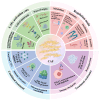Cancer-associated fibroblasts in clear cell renal cell carcinoma: functional heterogeneity, tumor microenvironment crosstalk, and therapeutic opportunities
- PMID: 40534854
- PMCID: PMC12174385
- DOI: 10.3389/fimmu.2025.1617968
Cancer-associated fibroblasts in clear cell renal cell carcinoma: functional heterogeneity, tumor microenvironment crosstalk, and therapeutic opportunities
Abstract
Clear cell renal cell carcinoma (ccRCC) progression heavily relies on the immunosuppressive tumor microenvironment (TME). In the ccRCC TME, the cancer-associated fibroblasts (CAFs) drive a self-perpetuating cycle of immune evasion and therapeutic resistance through diverse interactions between cells and molecules. Furthermore, heterogeneous CAFs facilitate tumor growth through metabolic reprogramming and modulate immune suppression by driving the M2 polarization of tumor-associated macrophages (TAMs) and the expansion of regulatory T cells (Tregs), which promote a multilayered immunosuppressive network. In addition, CAFs reshape the mechanical properties of extracellular matrix (ECM), hinder the infiltration of cytotoxic T lymphocytes (CTLs) and further exacerbate immune escape. Moreover, CAF-derived exosomes can confer resistance to chemoradiation therapy. Interleukin-6 (IL-6) secreted by CAFs synergizes with vascular endothelial growth factor (VEGF) to facilitate adaptive resistance to targeted therapy. Emerging therapeutic strategies-including fibroblast activation protein (FAP)-targeted CAR-T cells and transforming growth factor-β (TGF-β) inhibitors-can partially reverse this immunosuppressive property. Combination therapies employing immune checkpoint inhibitors and VEGF antagonists exhibit promising synergistic effects, although the clinical translation remains hampered by CAF heterogeneity, dual functional roles, and the lack of specific biomarkers. Future studies should integrate single-cell sequencing and spatial multi-omics techniques to comprehensively analyze the spatio-temporal dynamic heterogeneity of CAF subpopulations and develop precision treatment strategies based on molecular subtyping, aiming to break the vicious cycle of "CAF-TME-resistance" in ccRCC.
Keywords: cancer-associated fibroblasts (CAFs); clear cell renal cell carcinoma (ccRCC); combination immunotherapy; immune evasion; therapy resistance; tumor microenvironment (TME).
Copyright © 2025 Wang, Zhao, Xu, Liu, Zhong, Wu, Zhang and Wei.
Conflict of interest statement
The authors declare that the research was conducted in the absence of any commercial or financial relationships that could be construed as a potential conflict of interest.
Figures

Similar articles
-
Regulatory T cells and matrix-producing cancer associated fibroblasts contribute on the immune resistance and progression of prognosis related tumor subtypes in ccRCC.Sci Rep. 2025 Jul 1;15(1):20533. doi: 10.1038/s41598-025-06051-4. Sci Rep. 2025. PMID: 40596367 Free PMC article.
-
Deciphering the tumor immune microenvironment: single-cell and spatial transcriptomic insights into cervical cancer fibroblasts.J Exp Clin Cancer Res. 2025 Jul 5;44(1):194. doi: 10.1186/s13046-025-03432-5. J Exp Clin Cancer Res. 2025. PMID: 40616092 Free PMC article.
-
Delivery of miR-224-5p by Exosomes from Cancer-Associated Fibroblasts Potentiates Progression of Clear Cell Renal Cell Carcinoma.Comput Math Methods Med. 2021 May 24;2021:5517747. doi: 10.1155/2021/5517747. eCollection 2021. Comput Math Methods Med. 2021. Retraction in: Comput Math Methods Med. 2025 Aug 4;2025:9860529. doi: 10.1155/cmmm/9860529. PMID: 34122615 Free PMC article. Retracted.
-
Immune Checkpoint Inhibitors in Clear Cell Renal Cell Carcinoma (ccRCC).Int J Mol Sci. 2025 Jun 11;26(12):5577. doi: 10.3390/ijms26125577. Int J Mol Sci. 2025. PMID: 40565041 Free PMC article. Review.
-
Paracrine signaling in cancer-associated fibroblasts: central regulators of the tumor immune microenvironment.J Transl Med. 2025 Jun 23;23(1):697. doi: 10.1186/s12967-025-06744-4. J Transl Med. 2025. PMID: 40551209 Free PMC article. Review.
References
Publication types
MeSH terms
LinkOut - more resources
Full Text Sources
Medical
Miscellaneous

